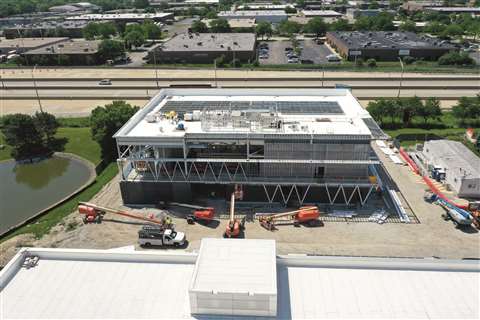Construction technology trends for 2023
13 December 2022

As the engineering and construction industry continues to confront disruptions stemming from Covid-19, shifting project types, increased competition, and a retiring labour force, we are starting to see how the way we work has changed forever.
In the construction industry, the primary use cases for new technologies during the pandemic were remote worksite monitoring to bolster worker safety and progress reporting, supply chain management, and enhanced sustainability for green construction projects.
Top construction technology trends, 2023:
Worker safety
Safety has and always will be a top priority in the construction industry. Organisations are constantly looking for ways to mitigate risk and improve working conditions. The contractors who have implemented advanced tracking technologies on the jobsite, such as vests with tracking chips, were able to help promote social distancing by creating real-time worksite maps. Project teams were able to closely monitor worker proximity and contact tracing, etc.
In 2023, we are we are poised to see safety technology move from identifying potential hazards to predicting future hazards.
Combined with AI, organisations might use visual sensor data to track people and machinery to understand what happens and where it happens on a site, helping identify potential hazards before they unfold. As these technologies continuously track what heavy machinery is in use, where project materials are left, and how people move throughout a job site, they can help managers recognize potentially dangerous situations and attempt to mitigate them before anything bad happens.
Remote site management to increase operational efficiency
The days of every employee commuting to work every day seem to be behind us. In the construction industry, that means using remote site monitoring technologies to better understand what is happening on the job site in real-time.
At the Oracle Industry Lab near Chicago, US, we have been testing various technologies in a 5G-enabled workplace of the future. Using drones, sensor data, robotics, and more, we help our customers and partners keep an eye on a job site remotely in a web browser or mobile device. These technologies combine safety, quality, and operational efficiency to give site project managers peace of mind that they don’t need to drive hours out of their way to check on each site every day.
I am not saying these technologies will make managing a construction site a fulltime remote responsibility, but it does allow for firms to turn it into a hybrid position.
 Dr. Burcin Kaplanoglu
Dr. Burcin Kaplanoglu
Supply chain technologies
One of the most essential lessons learned over the past few years has been how it is impossible to predict how potential delays in global supply chains can result in material shortages, and how that can impact project timelines.
Thankfully, supply-chain technologies are continuing to get better, and smart construction technology platforms allow teams to connect project scheduling information with design coordination connecting across related engineering and construction documents as well as automating supplier contract and payment management. Delivery teams are able to connect critical documents across a single source of truth, or common data environment (CDE), including submittals, drawings, specifications, warranties, and instructions.
This allows teams to universally connect, update, and synchronize information across an entire project. For example, if a material’s price or availability changes suddenly, you may be able to quickly make the adjustment and see its impact on your budget and timeline. Connecting the office to field workflows to continue to advance real time project productivity and resource tracking.
A unified, interoperable solution like this helps ensure that related documents are stored together, and the project schedule can stay on track.
Sustainability will move beyond corporate goals
Most companies by now have outlined their environmental, social, and governance goals, detailing how they plan to move to greener technologies and help curb climate change. Looking forward, construction firms will look to not only just meet those goals, but to exceed them. To help assist in that process, we recently built an Oracle Industry Lab in Reading, England, focused on achieving higher levels of sustainability. The lab is set to drive sustainability, mobility, and accessibility use cases with customers and partners.
 Drone image from Oracle Innovation Lab, which tests a whole host of new construction technology
Drone image from Oracle Innovation Lab, which tests a whole host of new construction technology
Predicting how natural disasters or the effects climate change could have on an asset is a difficult task, but intelligent construction platforms purpose-built for the industry can improve decision-making. Predictive insights garnered through the use of AI might help mitigate risks and assist in lowering carbon emissions. For example, digital documents, drawings, and 3D models can help reduce paper consumption. Even more helpfully, though, these construction technologies can help reduce waste and costly rework by visualising the end result before construction begins.
Construction companies have constantly been looking for ways to make their businesses more sustainable, and data analysis can be part of the solution. Data analytics can change how everything is constructed, from individual buildings to major public infrastructure projects and even entire cities. Data can help teams measure the sustainability of current construction methods and leverage those insights to show sustainability throughout the entire construction lifecycle’s plan, build, and operate phases. Data can help propel the built-asset industries toward long-term sustainable development methods.
Construction technology trends 2023 and beyond
Organisations will continue to look to new construction technologies to make job sites safer and projects more sustainable. With smart construction technology platforms, drones, sensors, and more, the job sites of the future are poised to be more sophisticated than ever before. This is an exciting time, and 2023 will see the construction firms continue to do what they do best: keep making buildings better than ever before.





